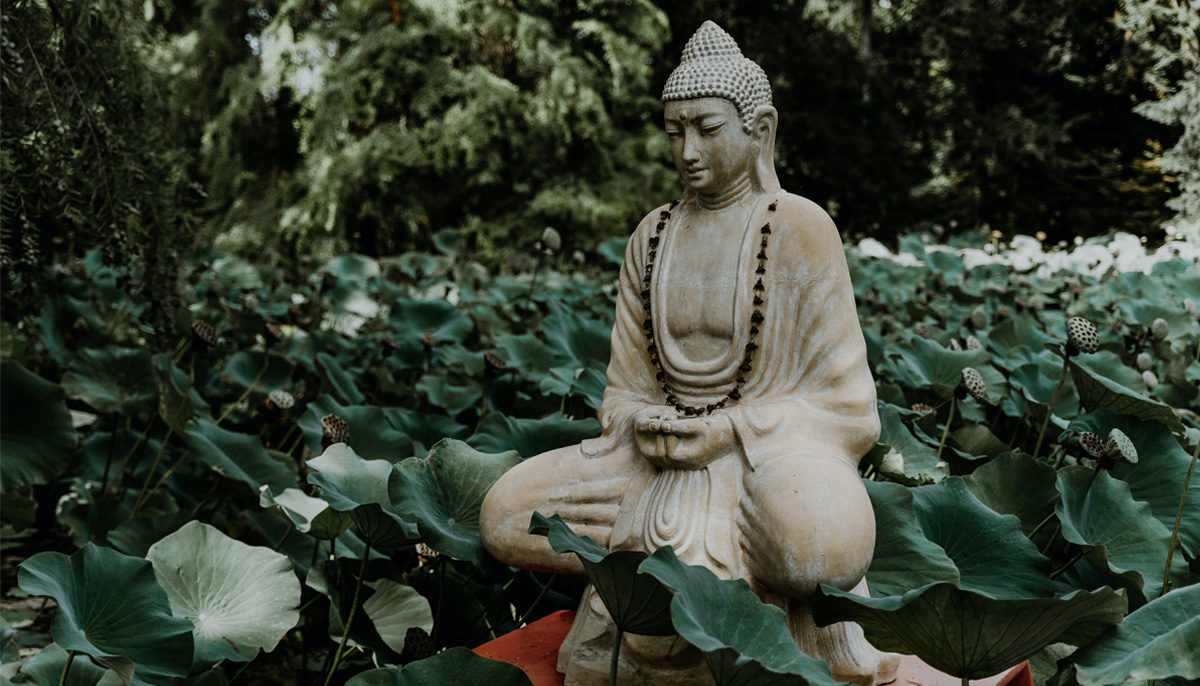We live in a world shaped by systems of violence. We are the inheritors of that violence and of those who created it. As inheritors and participants in systems of violence, it isn’t enough to simply renounce violent actions; we need to ask ourselves how systems shape our views and behaviors, how we contribute, at times unwittingly, to upholding their destructive outcomes; we need to cultivate practices of embodied nonviolence as acts of resistance and restructuring.
Systemic violence powers itself through forces external to individuals, like the false narrative of white supremacy. Internal forces provide energy, too—like the false views and harmful habits we each carry within us and enact in our moment-by-moment experiences.
When we begin working toward embodied nonviolence, we see that, although we can’t change history, we can change the power it exerts over us.
We live in a world shaped by white supremacy and the suffering it causes. I have found the practice of cultivating curiosity to be a useful tool in uncovering the ways these forces continue to operate in me. Perfectionism, dualistic thinking, individualism, conflict avoidance, and assuming my way is the only way are some of the habits that serve to uphold white supremacy. I have noticed these and other tendencies in my own mind and body, and I have witnessed the ways in which they reinforce violence within myself and others.
As a light-skinned, queer, second-generation Latinx person, I recognized systemic violence at an early age and decided I didn’t want to participate. Through experiences of both marginalization and privilege, I could see how my life had already been shaped by white supremacy as an ideology and worldview. I wanted to be free from the harmful effects of both.
After graduating from an elite, all-women’s college in the late nineties, I moved from Boston to San Francisco in search of a place of belonging and a life liberated from systems of violence. In a way, I was following in the footsteps of the Buddha, who left home as an act of renunciation. He rejected the high-caste warrior status of his family of origin; he also rejected the systems of violence he recognized in the milieu of his birthplace of India 2,500 year ago.
Like the Buddha, I had the privilege to choose where and how I wanted to live. And, like him, I rejected the idea that life was about living as comfortably as possible, often at the expense of others. Instead, I was committed to working in the local community and living simply. Rather than benefiting from systems of violence, I wanted to direct my energy toward working in solidarity with those seeking liberation from those systems. I became a youth worker, helping families and young people to navigate the often openly hostile worlds of the education system, the juvenile justice system, immigration, and housing.
I was also seeking solidarity with other queer folks and people of color committed to lives of nonviolence. I became active in local organizing—against draconian criminal justice laws, against war, for gay marriage. I threw myself into my work and activism, only to find that the biggest obstacle to showing up as fully as I could was my own mind. I realized the first step toward embodying nonviolence was the unlearning of my own internalized oppression, all the ways in which I had swallowed the messages of white supremacy whole and allowed them to shape the views I held of myself and the world.
In going forth from home, the Buddha devoted himself to understanding suffering and developing ways of freeing oneself and others from it. After his awakening, the Buddha spoke out against the caste system and the destructive views upon which it was predicated. He rejected the idea that some people are inherently better or worse than others based on the caste into which they were born. He recognized that continuing to live within the caste system was to uphold injustice, and so he dedicated his life to living outside of it, teaching and leading others for the rest of his life.
In the Dhammacakkappavattana Sutta, the Buddha taught the first noble truth of suffering. He understood that systems are creations of suffering individuals; therefore, systems themselves can perpetuate the suffering that results in violence. The Buddha encouraged his followers to closely examine the causes of suffering—for their own benefit and for the benefit of the systems they create. He offered tools for self-liberation and systemic liberation.
In my going forth from home, in seeking a life of nonviolence, I soon began incorporating these and other lessons of the Buddha into my practice. Teachings on karma and interconnection helped me understand how deeply shaped I am by social conditioning and how inextricably embedded I am in an endless, complex web of life. We are all conditioned by and participants in the creation of our world, moment by moment. Yet, this intellectual understanding did not free me from the underlying views that still operated within me, harmful habits that limited my potential to fully love and exist in solidarity with myself and others.
The messages I had received early in life—that nothing short of perfection is good enough, not to “rock the boat,” and not to question the system—began to reveal themselves in how I related to myself, others, my work, and my practice. I could see how the pressure to assimilate into mainstream culture and the coping mechanisms I had adopted to deal with that pressure created suffering for myself and others.
It started to become clear that this pressure, in and of itself, was rooted in violence. It required the suppression of my greatest asset, my deep sensitivity to the well-being of myself and others. Whenever I acted from a social location of dominance, didn’t speak up against an injustice, or failed to name a microaggression, I could feel the subtle violence of this pressure. Yet it wasn’t enough simply to notice these messages and their sway over me. The greater lesson I had to learn was how to unlock their grip on my life through awareness of the body.
In his book My Grandmother’s Hands, therapist Resmaa Menakem invites us to become aware of how we carry the trauma of living in a white supremacist culture in our bodies. I have used this approach to notice when and how in my day-to-day life I tighten, go numb, or become activated, which I’ve identified as the somatic echoes of the habits produced by violence. In this way, the violence of white supremacy can be felt directly, in this very moment of contracting, freezing, or flaring up in the body.
Each characteristic of white supremacy carries somatic qualities that can be felt directly in the moment of recognition. For example, when I become aware of perfectionism, I sense a tightening in my jaw, a contraction in my throat, an energetic cutting-off in my heart-center, and a sinking in my guts. When I notice this, I use mindfulness and compassion practices to support a pausing, turning toward, meeting directly, and abiding with these unpleasant, yet deeply familiar, sensations.
I may also bring to mind an intention, such as to let go of things needing to be a particular way, allowing the energy of remembering the intention to also move through me. There can be an alchemy to this work. Bringing an intention into relationship with whatever is happening now, no matter how painful, can have a transformative effect when done with great awareness and love.
At times, shame arises in the process. When it does, I remind myself that, although unpleasant, shame can be a catalyst for deep transformation, if we are courageous enough to sit with it. Shame carries the promise of restoration and renewal. That sinking feeling in the belly I mentioned earlier? I used to relate to it as my worthlessness. Every time I felt that gnawing sensation, I would submit to a voice that told me I wasn’t good enough, would never get it right, would always be less than.
But when I learned to sit with the feeling, just as it was, breathing a warm, loving space between the sensations and the thoughts and emotions that floated through my mind, I began to recognize something more true than the voice inside my head. It was my deep sensitivity to the wrongness of the situation. I realized there was nothing wrong with me. But what felt wrong was the world I was continuing to uphold by believing there was something wrong with me. What if I stopped believing this and simply allowed myself to feel the deep grief in seeing so clearly this painful habit? What if I allowed it to break my heart, and, in breaking it, reveal something much more precious and universal?
For many of us this work takes time and a great deal of patience. We may also need to turn toward other activities, resources, or modalities that can supplement our practice. Sometimes the part of me that resists going deeper into my somatic experience is too strong. Overriding it feels like an act of violence toward myself. When this happens, I do something else, like swimming, walking, meeting up with a friend, watching a movie, reading a book, eating a delicious meal. I bring pleasure into my life, not to indulge in it or use it as a form of escape, but to remind myself that there is a middle way between suppression and indulgence. This middle way includes enjoying life and resting for a little while. I may also seek out other supports, like therapy or medication, to get me through a particularly rough patch. Anything that helps is welcome in this work, as long as it doesn’t bring harm to ourselves or others.
Living in a white supremacist culture, formed over centuries, can feel intractable. Yet, when we begin working toward embodied nonviolence, we see that, although we can’t change history, we can change the power it exerts over us. We can begin to rewrite the narrative, learning to inhabit our bodies more and more deeply, giving shape to new ways of being and relating graced with an ethos of nonviolence. By doing so we reroute our collective trajectory toward a world that is predicated on nonviolence at its core. This rerouting begins with any moment of recognition of the harmful habits we are intending to break, bringing them into consciousness so they can be fully seen, known, and transformed. We can also find like-minded people, a teacher, and a community to help us along the way. Here are some examples of teachers, communities, and resources to get you started:
- The Inner Work of Racial Justice by Rhonda Magee
- Mindful of Race by Ruth King
- Radical Dharma byRev. angel Kyodo williams, Lama Rod Owens, and Dr. Jasmine Syedullah
- The Buddhist Peace Fellowship
- Buddhist Justice Reporter
- Bhumisparsha
- White Awareness Is Revolutionary
- White Awake
- The Radical Embrace
This work starts and ends in the body, as we turn toward these previously unconsciously held habits, begin to free the trauma held there, and heal ourselves, our communities, and the world.
This article was created in collaboration with Buddhist Justice Reporter (BJR), founded by BIPOC Buddhist practitioners in response to the police torture and murder of George Floyd. BJR publishes articles on issues related to environmental, racial, and social justice and its intersections, from an anti-racist Buddhist lens.

